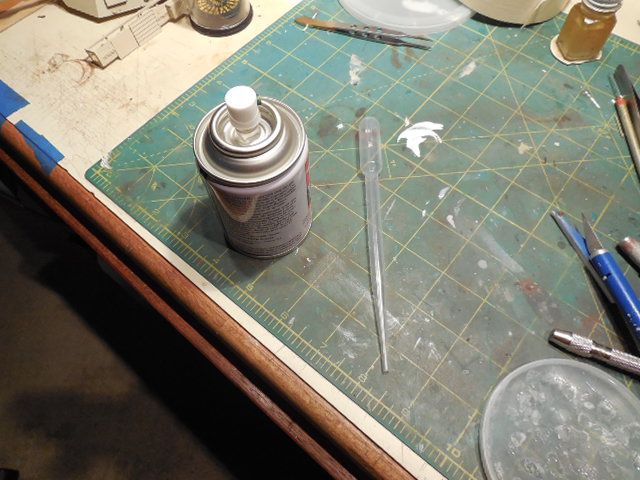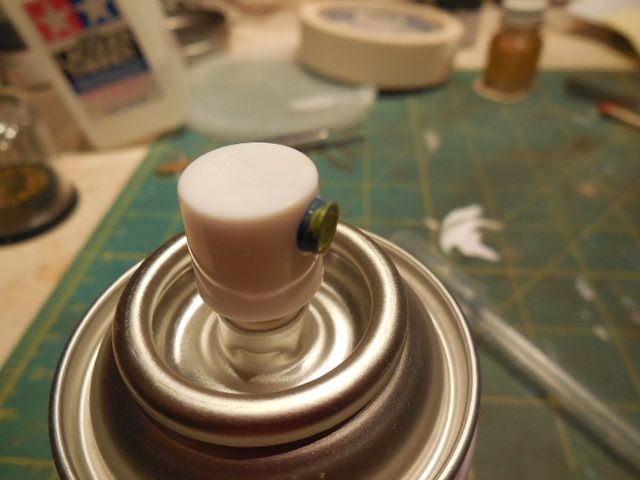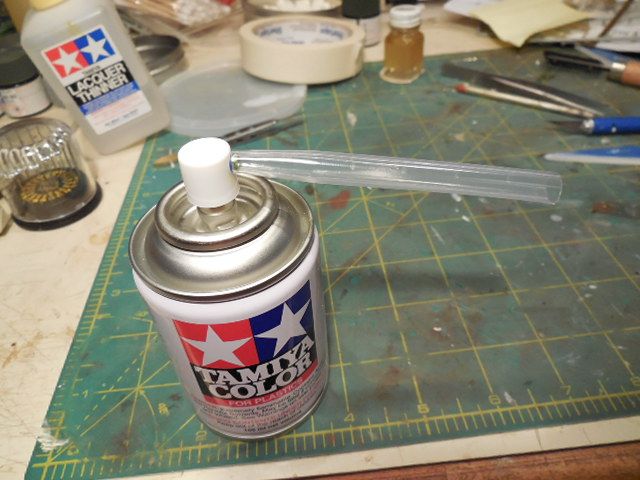I just saw someone (user name talentless) refer to decanting Tamiya Aerosol paints for airbrushing…how does that work, how do you do that? Also once decanted do they then work for brush application?
Just wonderin’
Blake
I just saw someone (user name talentless) refer to decanting Tamiya Aerosol paints for airbrushing…how does that work, how do you do that? Also once decanted do they then work for brush application?
Just wonderin’
Blake
I have decanted Tamiya paints many times but only to use in an airbrush for better control that a rattle can will allow. Tamiya has a nice little round bit that sticks out the front of the button. Cut the tapered end off a plastic dropper so it fits over the part the sticks out. Cut off the build and spray paint into a small jar or cup. Stir it for a while so it de-gases. This is the neatest… as in not messy… but it is kinds “cool” too[;)] way could come up with.
Faster and cheaper way is to use a drinking straw with the end slightly notched so it fits against the round spray button a little better. This take 2 hands and there will be some spray from around the straw so wear rubber gloves.
After I have used all the paint in a can a will save the button to use on other brands, if it fits, because of that little sticking out bit.



Hi Marc,
Thank you so much for the detailed response!
Blake
For brushing, I have sprayed from spray cans into paper cups. I do it in my spray booth, since there is quite a bit of backflow, but it works. It is a bit thin, but when you need to touch up a tiny spot with a brush and you need the color from the can- say for an edge that didn’t get covered- it is an easy way to go.
I use the straw method. put a little tape around the straw and covering the lid of the jar you’re spraying into (I use tinfoil held in place with a rubber band) saves a lot of mess.
Here’s what I don’t understand: how would the straw/tube method be any neater? I haven’t seen it done or tried it for myself yet but all I can think is that the aerosol is still going to blast the paint out just the same - does the tube somehow change the airflow?
Perhaps this VIDEO DEMO will help. There are a couple of others as well. But, yes, the straw/tube constrains the paint/aerosol so the paint can be sprayed into another container.
VERY interesting… all I could imagine was the paint being blasted out just the same - just not in a fine pattern from the nozzle. I cant help but wonder, as a pilot who takes pride in taking time to really study and understand the dynamics of flight, how the science behind that works. Mainly - where does the aerosol go? Is it because the paint contacts the tube that it gets immediately slowed down by parasite drag, which separates it from the air? If thats true then does the air get cut down by the drag of being in the tube as well? I know its not as important as “It works!!” but still… I can’t help but be curious!
I use jumbo straws which have a bigger bore and tape them to the nozzle.or you can use blutac. I also tape over the jar its going into and poke a hole in it to accept the straw. Why use a straw.? Think garden hose. The hole in a spraycan nozzle is tiny so it comes out fast. When spraying it into the straw the effective nozzle size is bigger so the pressure drop is larger, the paint just runs downnthe inside of the straw into the jar without making a mess. A slight bend in the straw helps with this too. Using a larger straw means the pressure drops more so you can use a shorter straw, and the larger straw gives u more wiggle room whe taping it to the can. I leave it in the jar with thevlid loose overnight to outgass.
wow, so many good tips. I’ll be trying this for the first time this weekend. One last question: is the decanted paint normally thin enough for airbrush application, or should I have some thinner on hand?
You will still want thinner on hand, to adjust the mix accordingly for airbrushing.
Deaf Aviator- The propellant gas sill ends up in the cup you are catching your paint in. You need to wait up to an hour sometimes to let all the gas escape, or it will airbrush like crap. I’ve tried decanting in a cup, then pouring it in a container with a plastic cap on it to store it for future use, only to have the cap keep popping off until all the gases escape.
dont cap it tight for quite awhile because if you do before it out gasses paint will shoot everywhere when you un cap the bottle.
Bill
So I finally tried this decanting devilry and hey! It’s pretty neat stuff! I think I am hooked - well I WOULD be if spray paints weren’t so expensive! But the benefits of it being ready to shoot right out of the jar with no thinning needed make it well worth the hassle to do this. I absolutely love it.
What I do is I use my throwaway droppers, with the tip cut back to fit the nozzle, which is then superglued and taped to ensure a good seal on the nozzle, then the squeegee end chopped open to drain the paint. I actually don’t need to constrain everything in a covered bottle/jar/cup because the squeegee end of the tube slows everything down even more so that I can just spray right into a small glass cup. I let it air out until it stops bubbling (about half an hour) then it’s ready to shoot. I like that I can spray out just however much I need and not a whole lot more to waste.
I also just leave the tube attached to the paint jar, hence the superglue and tape.
I’ve used all the above techniques. I have also been known to just spray directly into a paper cup when in a hurry and just needing a small amount of the paint for touch up work with a brush.
I always wear a pair of those vinyl gloves because the blow back goes everywhere! If you are careful in removing them you can continue to reuse the same pair of gloves because they generally do not get very messy.
So finally tried this out myself and like Todd, I’m hooked.
I used a Tamiya gloss pure white. The only pitfall I faced was that it seemed the last bit of the can I decanted was not as good as the first. Maybe shouldn’t go to the bitter end of the can…the last shot, I just couldn’t seem to get it degassed well.
Great way to go though. Saves paint big time. A lot of the good model paints can only be found in rattle cans, to get airbrush results, worth the trouble.
-Blake
Scratch that last comment, the results were great. The problem was my airbrush.
Well I should clarify, the problem was me not knowing how to use my airbrush.
Sure a lot of learning this hobby, that’s why I love it!
-Blake
Hello all.
I decanted my first rattle can last weekend and the process and end product was great. I took my first attempt at applying with my airbrush and that was a disaster. I was hoping that the paint would be thin enough to just pour in and shoot. This was not the case. Make sure that you have some airbrush thinner handy. Test your mix before you shoot. Hope this helps.
-Roy
Decanting is great; however, be careful of what you are decanting into, especially Tamiya paints. I decanted two different paints, one Tamiya white and one MM white into the same type of container. From what I can figure, Tamiya solvents are little hot for some plastics. The containers I used claimed that the were good for all paint types. Anyhow, the one with Tamiya paint softened the plastic and it stuck to my desktop and left me a nasty surprise when I went to use it.
Be on the safe side i always use glass bottles to decant spray cans. ACESES5 ON BENCH MONOGRAM C47 & PARATROOPERS 1/48 [snWcm]
Just curious, what paint are we talking about that only comes in spray cans? I can’t quite figure out the need for this operation, but obviously there is a significant one.
Jay